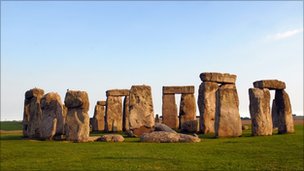Erected between 3000 and 1600 BC, Stonehenge is the most eloquent testimony to the once dominant civilisations of the Stone and Bronze Ages. And what better way to unravel the mysteries of Stonehenge’s innermost circle than on a private tour in the company of an expert from English Heritage?
 As well as inspecting Stonehenge's antique trilithons at close hand, our early morning visit will reveal how recent excavations have radically altered interpretations about this most monumental of temples.
As well as inspecting Stonehenge's antique trilithons at close hand, our early morning visit will reveal how recent excavations have radically altered interpretations about this most monumental of temples. The ceremonial landscape that lies around Stonehenge is richly suggestive of Wessex’s ancient patrimony: we will explore the Great Cursus, the henges of Durrington Wall and Woodhenge, and a handful of the great Bronze Age barrows that bestride the surrounding hills.
The majestic façade of West Kennet chambered long barrow, framed by two enormous quarry ditches, was constructed around 3650 BC – some four centuries before the first stones were raised at Stonehenge. Immediately to the west lies Avebury, the world’s largest pre-historic stone circle, further graphic confirmation of the outstanding engineering skills of our megalithic ancestors.
We stay in Salisbury at the 17th century three-star White Hart Hotel overlooking the famous mediaeval cathedral
Itinerary
Day 1 Course assembles 1600 for two nights at Mercure White Hart Hotel, Salisbury. Evening: sherry reception followed by course introduction.
Day 2 Early morning privileged visit to Stonehenge (inner circle) followed by Neolithic henge monuments of Durrington Walls and Woodhenge, Stonehenge Cursus, King Barrows (unexplored Bronze Age barrows), Stonehenge Avenue (ceremonial approach). Evening talk.
Day 3 Avebury Henge (huge earthwork enclosing three stone circles), Silbury Hill (largest man-made mound in Europe), West Kennet long barrow (early Neolithic chambered tomb). Course disperses 1700 at hotel.
Cost
Cost of £490 includes: accommodation based on sharing a twin or double bedded room, drinks reception, breakfast, two packed lunches & two dinners, special entry to Stonehenge, excursions & admissions (except English Heritage properties for non-members).
Not included: travel insurance, single room supplement £110.
This tour is operated by the Engish Heritage and Ace cultural Tourshttp://www.acestudytours.co.uk/
http://www.english-heritage.org.uk/book-and-buy/partner-products/leisure-and-travel/uk-study-tours/
http://www.stonehengetours.com/
Wessex Tour Guide






